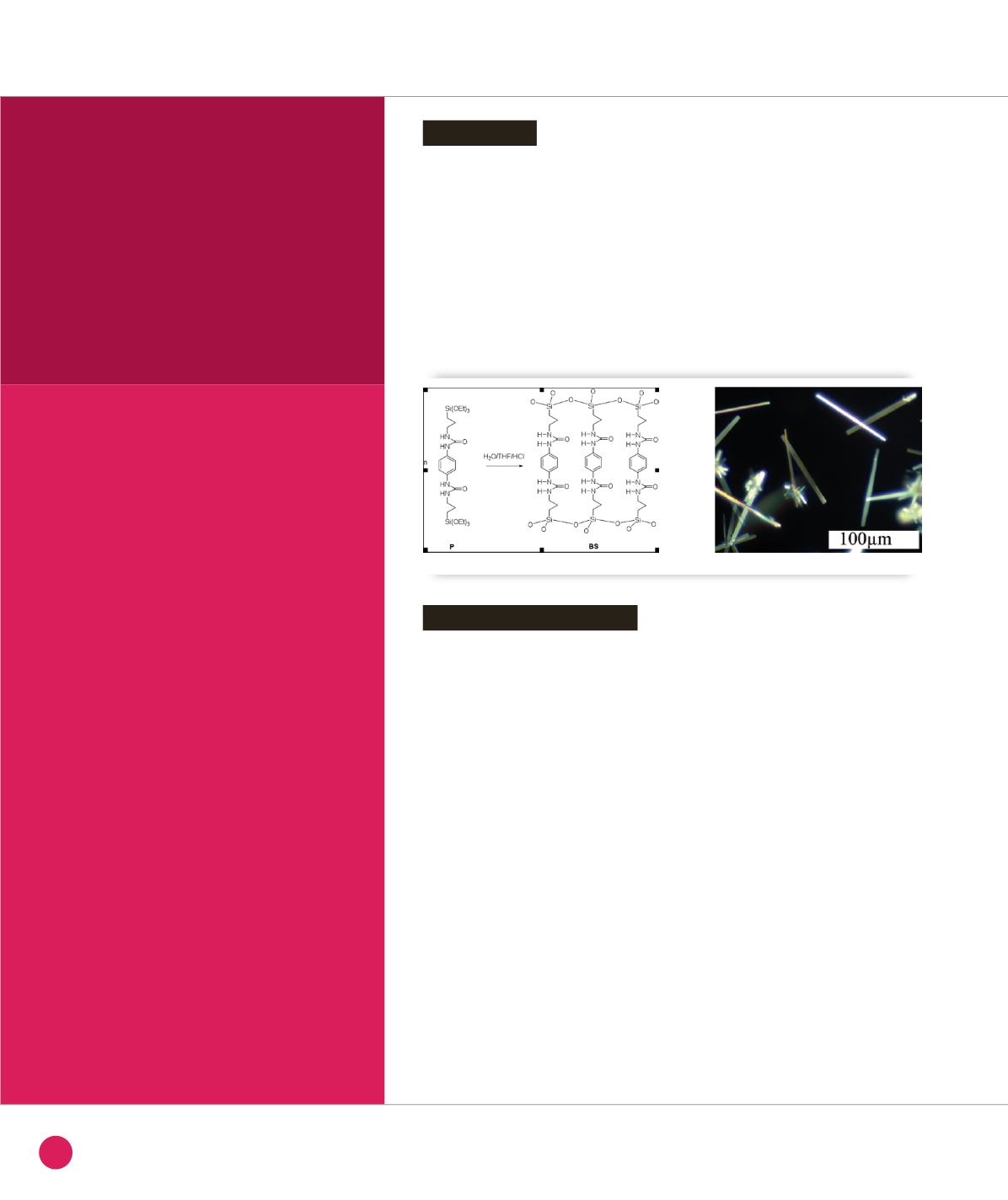
Self-structuring of bridged
silsesquioxanes through
covalent and non-covalent
bonding
The self-structuring of a bridged
silsesquioxane during sol-gel synthesis
has been investigated by
in situ
optical
microscopy (OM), light scattering (LS)
and infrared spectroscopy (IR).
The evolution of the system as a function
of processing time was correlated with
covalent interactions (polycondensation)
and non-covalent interactions (H-bonding).
A comprehensive mechanism based
on the hydrolysis of the organosilane
precursor
P
prior to the crystallization
of the corresponding
BS
via H bonding
and subsequent irreversible
polycondensation is proposed.
Bridged silsesquioxane (
BS
) is an
emerging class of hybrid material with––
covalently Si-C bonded organic functions
to silica. They are obtained by the sol-gel
hydrolysis of molecular precursors in
which the organic part is connected to
several silicon atoms bearing hydrolysable
alkoxy groups. New properties can be
tuned to these materials according to the
organic function which can also induce
the self-structuring of the resulting
hybrid. Indeed, it was found that during
the hydrolysis-condensation of
P
, self-
assembly occurs with the formation of
H-bonds resulting in a crystalline
BS
(Figure
➊
) as confirmed in former studies
by TEM and PXRD studies [1,2]. Since two
processes (H-bonds and Si-O-Si bond
formation) may interfere in the structuring
during the hydrolysis-condensation of
P
,
in situ
OM, LS and IR measurements have
been performed to determine the key
factors of the structuring processes.
OM analyses show the nucleation and
growth of rectangular needles which
display a strong and uniform birefringence
indicating the formation of single crystals.
In combination with LS experiments,
three domains were determined (Fig.
➋
a
):
Domain I (10 min) indicates no molecular
aggregation; nucleation of microcrystals
occurs in Domain II and slows down into
the final crystal shape in Domain III.
The hydrolysis-condensation steps
(covalent bonding) monitored by MFTIR
(900-1300 cm
-1
) to probe the
ν
as
Si-O
(condensation) and the
ρ
CH
3
(hydrolysis)
vibrations reveal an increasing intensity
of
ν
a
as
Si-O together with a decreasing
intensity of
ρ
CH
3
(Fig.
➋
b
) [3,4]. These
can be correlated to the 3 domains above:
hydrolysis (up to 50%) of
P
(Domain I)
with no polycondensation until 10
min after which time the hydrolysis
rate decreases with a concomitant
crystallization. Condensation then starts
with a rapid crystal growth until 20 min
(Domain II) and in Domain III no change
of crystallite size is observed while
condensation continues (aging).
The self-assembly via H-bonding
formation (non-covalent interaction) was
also monitored by MFTIR (1350-1750
for amide-1,
ν
CO and for amide-2,
δ
NH
).
The results (Fig.
➋
c-e
) are again related
with the 3 domains (Fig.
➋
c
): only free
molecules are present (Fig.
➋
d
) in Domain
I determined by the absence of H-bonding
(free mode at around 1686 cm
-1
). In
Domain II, concomitant condensation and
H-bonding formation occur (
ν
CO
shifts at
lower frequency, 1635 cm
-1
). The intensity
variations of the amide-2 mode (Fig.
➋
e
)
are consistent with this interpretation
(emergence of a band at around 1590
cm
-1
). After 50 min (Domain III) a slight
downshift of the H-bonded CO (4 cm
-1
)
as well as a narrowing and an increasing
intensity of the peak with time is observed
(Fig.
➋
d
) indicating a strengthening of
H-bonds while polycondensation proceeds
and is consistent with further local
rearrangement or intermolecular ordering
in the system.
Introduction
Results and discussions
CHEMISTRY AND PHYSICAL CHEMISTRY, NANOCHEMISTRY
➊
Sol-Gel synthesis of crystalline
BS
36
SYNCHROTRON
HIGHLIGHTS
2013


